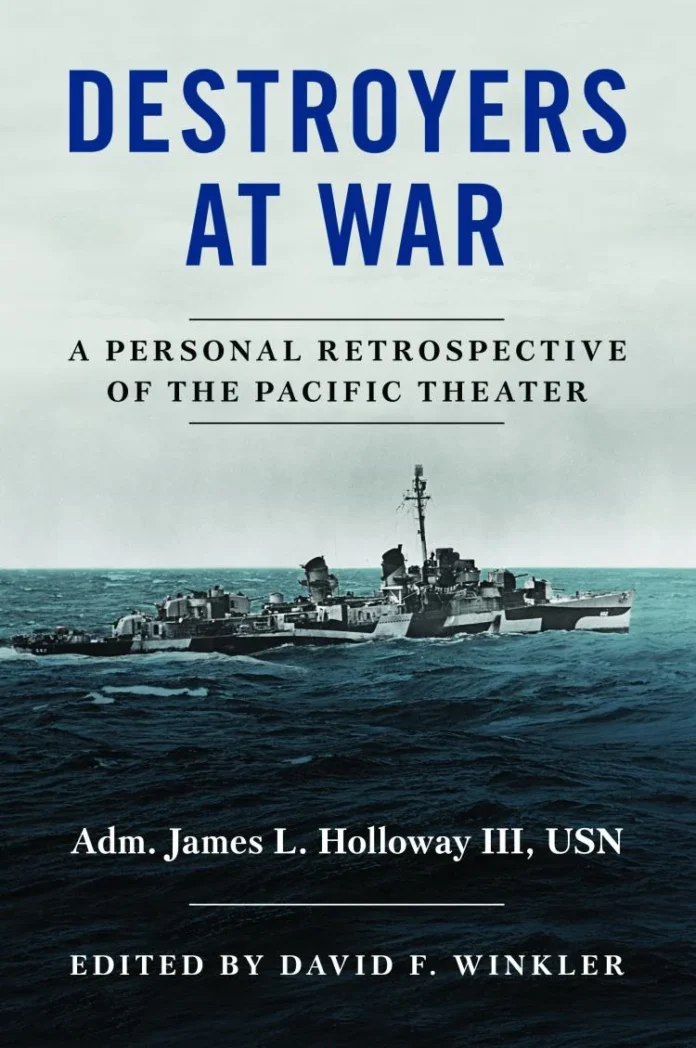
Destroyers at War; A Personal Retrospective of the Pacific Theater – Admiral James L Holloway III, USN. David F Winkler ed. Naval Institute Press, Annapolis, 2025
Reviewed by Tim Coyle
The book’s rather bland title – Destroyers at War – covers the wartime service of James L Holloway III, a junior US Navy officer serving in two Fletcher-class destroyers: USSs Ringold and Bennion, the latter in the Southwest Pacific theatre in 1943/1944 as gunnery officer. He saw action in the amphibious landings and fleet actions from the Marianas, through Eniwetok, Palau, Manus, the Philippines and Leyte Gulf.
His action station in the Mk 37 gunnery director allowed him a panoramic view of the engagements which are described in a professional and personal manner.
While James Holloway writes as a Lieutenant USN, he and his father, James L Holloway Jnr., held the distinction of both achieving four-star rank on active duty, the son serving as Chief of Naval Operations from 1974.
To situate Holloway’s destroyer service in his life, the book’s Prologue describes his childhood and early life in a navy family posted around the US and to the Asiatic Fleet in the 1920s and 30s. Holloway’s personal memoirs commence with his time at the US Naval Academy, which he entered in 1939 as the Class of 1943. The Class graduated a year earlier in June 1942 due to wartime exigencies. He had married and was destined for destroyers. Such was the frenetic pace of US industrial mobilisation – particularly in shipbuilding – that Ensign Holloway was sent to Harvard University to supervise intakes of temporary specialist officers. The narrative describes the difficulty in securing accommodation for himself and his wife and how he and his colleagues managed the new entry officers who, although skilled in their professional lives, knew nothing about the Navy.
Holloway’s first destroyer was USS Ringold, which he joined in December 1942. Ringold was New York based and operated in the Atlantic as far as Casablanca and spent time at the Naval Operating Base Trinidad. Ringold deployed to Hawaii in August 1943 and Holloway detached for subsequent appointment to Bennion, in which he served his combat tour. As gunnery officer, he notes precise expenditure of ordnance in his narrative in his highly detailed descriptions of the actions in which the ship participated. Bennion was often on radar picket duty which was especially vulnerable to Japanese air attack. He describes the Combat Information Center arrangement in the ship, a concept pioneered in the USN. inspired by British practice, which proved invaluable in air defence of the fleet.
Liberty opportunities were practically non-existent; Holloway describes the bar facilities in the vast anchorage at Manus. Rudimentary at best, huge bars were provided for officers and sailors where ferocious spirits (‘rotgut’ according to Holloway) was dispensed in industrial quantities. Bar staff used improved tools which could puncture multiple cans at one blow, so urgent was the need to keep up with demand. Boat coxswains faced challenges in returning supine personnel to their ships; it was not unusual for them to be dumped onto any vessel to be sorted out when the victims returned to consciousness.
Holloway had harboured a desire to become a naval aviator since childhood, and he applied for flight training while in Bennion. His application was approved, and he left Bennion in November 1944 to take passage in a cargo ship, Dorothy Lykes, to the West Cast. His description of his detachment gives an insight of the extent of naval shipping in major anchorages:’ the signalmen in Bennion did a great job in finding Dorothy Lykes in the anchorage, using a combination of flashing light and TBS (Talk Between Ships) radio. It was a large anchorage, with ships spread out all over the place, many of them moving to offloading areas closer to the beach, warships and cargo vessels intermixed, most of the cargo vessels with their names or identification numbers painted over and replaced by very small writing. The whole anchorage seemed to be overhung by a pall of smoke left by gunfire, smoke from the ship’s stacks, and the FS chemical smoke’.
His commanding officer expressed his sorrow at losing him; Holloway summed up their mutual experiences in Bennion by saying: ’Captain, we silenced four shore batteries, shot down three Zeros, sank a destroyer by gunfire and made a torpedo attack that helped sink a Japanese battleship. I think I’d like to try something else’.
Holloway’s memoire concludes at this point. Editor Winkler, in Epilogue: Later Years, Final Honors, picks up the Holloway father and son in their later appointments which range through senior appointments including nuclear submarine development and naval personnel management.
Destroyers at War is an absorbing narrative of the Pacific War at sea told from the viewpoint of a junior officer. It is also an intriguing wider commentary of life in the US Navy from the 1920s to the 1970s.
Admiral James L Holloway III USN died on 26 November 2019, aged 97.



